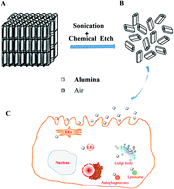Systematic investigation of intracellular trafficking behavior of one-dimensional alumina nanotubes†
Abstract
Nanotube materials exhibit high drug loading capacity and controlled drug release properties, providing new opportunities for drug delivery. However, the intracellular trafficking paths of 1-dimensional (1D) nanostructured materials are poorly understood compared to their spherical counterparts, impeding the broad application of 1D materials as drug carriers. Here, we report the intracellular trafficking mechanism of nontoxic and biocompatible nanomaterials called anodic alumina nanotubes (AANTs), a model for 1D materials with a geometry that can be precisely engineered. The results indicated that AANTs enter the cells mainly by caveolin endocytosis and micropinocytosis and that cells use a novel macropinocytosis–late endosomes (LEs)–lysosomes route to transport AANTs. Moreover, liposomes (marked by DsRed-Rab18) are fully involved in the classical pathway of early endosomes (EEs)/LEs developing into lysosomes. The AANTs were delivered to the cells via two pathways: slow endocytosis recycling and GLUT4 exocytosis vesicles. The AANTs also induced intracellular autophagy and then degraded via the endolysosomal pathway. Blocking endolysosomal pathways using autophagy inhibitors prevented the degradation of AANTs through lysosomes. Our results add new insights into the pathways and mechanisms of intracellular trafficking of AANTs, and suggest that intracellular trafficking and lysosomal degradation are highly interdependent and important for efficient drug delivery, and should be evaluated together for drug carrier development.



 Please wait while we load your content...
Please wait while we load your content...